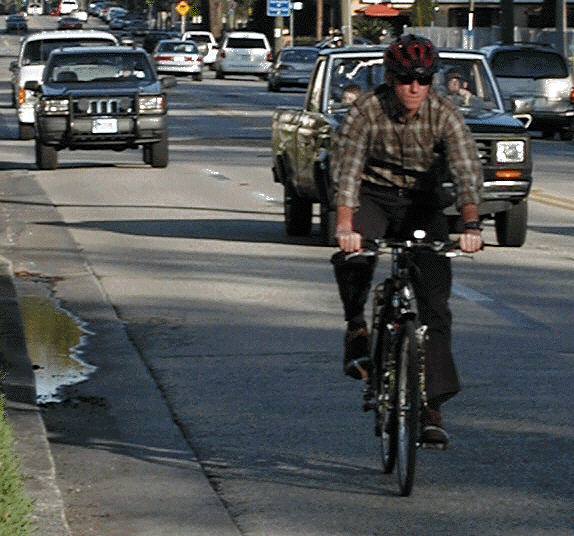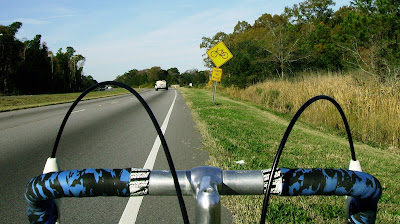Right where he should be
 Fri, May 8, 2009
Fri, May 8, 2009 
The cyclist in the above picture is riding right where he should be. I'm sure the driver of the dark colored SUV behind him doesn't think so. He probably thinks he should be another 18 inches to the right where the asphalt meets the cement gutter.
If the cyclist was riding there in all probability this driver would pass in the same lane and just about squeeze the cyclist off the road. You can see where the SUV's wheels are in relation to the edge of the asphalt on one side and the white line on the other that there is not enough room to safely pass a cyclist within the lane.
The term is called "taking the lane," which is precisly what this cyclist is doing. Any newcomer to cycling needs to learn this strategy as quickly as possible. Maybe you have decided to commute to work on a bicycle; either for economical reasons or for your health, or both.
Assert your place on the road. You are not cycling in traffic, you are part of traffic and your bicycle is a vehicle like all the other vehicles on the road. Also I should point out, subject to the same rules and laws pertaining to public highways.
You don't have to be an ass to be assertive, but at the same time you should not be expected to compromise your own safety by trying not to inconvenience others.
Returning to the above picture you can see it is only a very slight inconvenience for the passing driver to signal and move over to the other lane as the truck is doing. Let's say traffic is heavy and both lanes are full so the driver behind can't move over. Then he must wait behind the cyclist until he can move over.
It is possible the lanes will widen further on down the road; then the cyclist can opt to move over a little and drivers can pass safely within the same lane.
Car drivers need to realize that in heavy traffic you are going to be delayed anyway, and if you squeeze past the cyclist you place a human life at risk, and for what? You will be stopped again at the next light. Remember there are no fender-benders if you hit a cyclist. Bones break and people bleed.
By taking the lane the cyclist is also making himself highly visable. The most common car/bicycle accident is caused by drivers approaching from the opposite direction and and not seeing the cyclist, they make a left turn in front of them.
If the cyclist is on the extreme edge of the road and in the gutter, chances are there will be a car along side, or just in front of him hiding him from the view of the turning motorist.
By being in the position of the above cyclist, the turning driver can see him, and chances are there will be another car following closely behind the cyclist so the oncoming diver will not even consider turning at that moment.
The second most common accident is the "Right Hook." (Left Hook in the UK.) This is where the motor vehicle passes the cyclist then immediately turns right; the cyclist either runs into the side of the car, or in in a worse case the vehicle runs over the cyclist. This is less likely to happen if the cyclist is a little distance out from the curb.
By avoiding just these two most common accidents you make your cycling experience safer and more enjoyable; you can do so by taking the lane. Let me point out however, that taking the lane should never be abused and used just because you can.
If you can see traffic a hundred yards or so ahead of you then you are not really delaying anyone, you are simply making yourself visable by having that space in front of you.
Motorists need to realize there are going to be more and more cyclists sharing the road with them, and for every cyclist that means one less car which in the long run will ease conjestion.
Footnote: The excelent photo that illustrates this point so well is from Mighk Wilson's blog
 Dave Moulton | Comments Off |
Dave Moulton | Comments Off | 

















